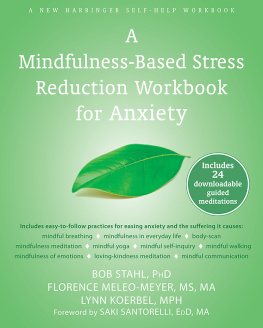Copyright
LEARNED MINDFULNESS ISBN: 978-0-12-816484-6
Copyright 2020 Elsevier Inc. All rights reserved.
No part of this publication may be reproduced or transmitted in any form or by any means, electronic or mechanical, including photocopying, recording, or any information storage and retrieval system, without permission in writing from the publisher. Details on how to seek permission, further information about the Publishers permissions policies and our arrangements with organizations such as the Copyright Clearance Center and the Copyright Licensing Agency, can be found at our website: www.elsevier.com/permissions.
This book and the individual contributions contained in it are protected under copyright by the Publisher (other than as may be noted herein).
Notices
Practitioners and researchers must always rely on their own experience and knowledge in evaluating and using any information, methods, compounds or experiments described herein. Because of rapid advances in the medical sciences, in particular, independent verification of diagnoses and drug dosages should be made. To the fullest extent of the law, no responsibility is assumed by Elsevier, authors, editors or contributors for any injury and/or damage to persons or property as a matter of products liability, negligence or otherwise, or from any use or operation of any methods, products, instructions, or ideas contained in the material herein.
Publisher: Nikki Levy
Acquisition Editor: Joslyn Chaiprasert-Paguio
Editorial Project Manager: Susan Ikeda
Production Project Manager: Sujatha Thirugnana Sambandam
Cover Designer: Mark Rogers
Cover images supplied by: Frank John Ninivaggi
125 London Wall, London EC2Y 5AS, United Kingdom
525 B Street, Suite 1650, San Diego, CA 92101-4495, United States
50 Hampshire Street, 5th Floor, Cambridge, MA 02139, United States
The Boulevard, Langford Lane, Kidlington, Oxford OX5 1GB, United Kingdom

List of Figure
- Fig. 1.1 Rendering of the classical Mahaprajnaparamita-hridaya Sutra or Heart Sutra by Frank John Ninivaggi. 19
List of Tables
- Table 1.1 Consciousness, Self-Awareness, and Ego. 3
- Table 1.2 Buddhism's Four Noble Truths. 14
- Table 1.3 Mindfulness and the Awakening of Mindfulness. 16
- Table 2.1 Benefits of Mindfulness: Self-regulation Managerial Alignments of Attention. 39
- Table 2.2 Sitting Practice Meditation: Three Types and Their Distinctions. 42
- Table 3.1 Emotional Intelligence Definitions. 49
- Table 3.2 Neuroscience Correlates of Emotional Processing. 53
- Table 4.1 The Burnout Syndrome. 78
- Table 4.2 Emotional Self-Regulation. 87
- Table 4.3 Benefits of Learned Mindfulness . 91
- Table 5.1 Authentic Integrity. 103
- Table 6.1 Wellness, Physician Engagement, and Organizational Alignment. 117
- Table 6.2 Three Pillars of Learned Mindfulness . 132
About the Author
Frank John Ninivaggi, MD, is an associate attending physician at Yale New Haven Hospital, an assistant clinical professor of child psychiatry at the Yale University School of Medicine's Child Study Center in New Haven, Connecticut, and the psychiatric director of the Devereux Glenholme School in Washington, Connecticut.
Dr. Ninivaggi received his adult psychiatric training at Johns Hopkins University School of Medicine in Baltimore, Maryland. He is Board Certified by the American Academy of Psychiatry and Neurology. He received specialty Fellowship training in child and adolescent psychiatry at the Yale Child Study Center, where he continues to hold dual university and Yale New Haven Hospital Health System appointments. He also received training in intensive child therapy in London in the late 1970s and early 1980s at the Anna Freud Center and the Tavistock Institute for Human Relations. In 1973, he trained in Clinical Medicine at the Radcliffe Infirmary Hospital at Oxford University, England, where he received honors under Dr. Paul B. Beeson, former chairman of Yale's Department of Internal Medicine. He also received formal training in Ayurvedic Medicine and holds a diploma in Ayurveda (Ayur. D) from the Western New England Institute for Ayurvedic Studies. Before entry into medical school, he trained in painting with artists Paulina Peavy and Maulsby Kimball in New York City and took courses at the Brooklyn Museum.
He is in private practice, performs school consultations, writes, and teaches at Yale. In 2004, he received the distinction of certification as a Life Fellow of the American Psychiatric Association. He has been a longtime member of the Connecticut State Medical Society. He is an active member of Yale's Physician Wellness, Engagement, and Burnout Prevention committees.
His long-standing research on conceptual intelligence, Borderline Intellectual Functioning and Academic Problems, has been published in Sadock, Sadock, and Ruiz (Editors), Kaplan & Sadock's Comprehensive Textbook of Psychiatry , 8th edition (2005), 9th edition (2009), and 10th edition (2017). His new chapter, Malingering, is included in the 9th and 10th editions.
Dr. Ninivaggi's publications include the following textbooks: Ayurveda: A Comprehensive Guide to Traditional Indian Medicine for the West (2008, 2013), Envy Theory: Perspectives on the Psychology of Envy (2010), Biomental Child Development: Perspectives on Psychology and Parenting (2013), Making Sense of Emotion: Innovating Emotional Intelligence (2017) and a chapter, The Psychology of Aging, in Yue et al. (eds.), The Comprehensive Treatment of the Aging Spine: Minimally Invasive and Advanced Techniques (2011).
Foreword
We are blessed and cursed by technology. Alive in a time unparalleled in the amount of available information and efficiency in any one moment, right at our fingertips, this level of connectedness also leaves us, more than ever, disconnected from each other. This removal from the patient is especially true for physicians and clinicians: we have a seemingly ever-increasing set of demands for treating our patients in guidelines and algorithmically based manners, and of course, documenting everything via our heralded (and mandated) electronic medical record.
Forced to choose between facing our computer terminals or our patients as we take their histories, our minds do mental mathematics, algorithms of their own trying to come up with the impossible solution of how to document encounters in time to get home for dinner (or if that seems impossible, at least a few hours of sleep), connect authentically with each patient, formulate an accurate diagnosis, and develop a treatment plan. All in the oft-quoted (and derided) 7-min visit.
Enter mindfulness. Not (though sometimes) viewed as some magical panacea, but instead, an inherent capacity that can be fostered and learned, mindfulness has seen an unprecedented resurgence from its humble millennia-old roots to modern-day medicine. Why? Frankly, one primary driver is the emphasis on understanding its underlying science and validating its effects through medicine's systematic approaches such as randomized controlled trials.














